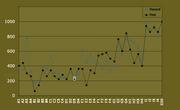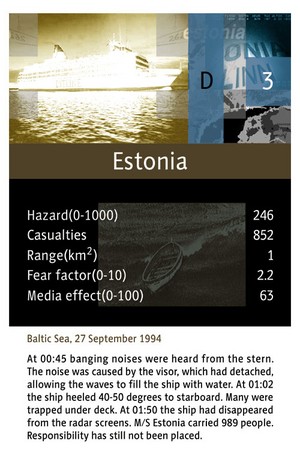|

The M/S Estonia set out from the harbour of Tallinn, Estonia, on 27 September 1994 at approximately 7 p.m. It was heading towards Stockholm, Sweden, and carried 989 people: 803 passengers and 186 crewmembers. The vessel was also carrying 40 trucks/trailers, 25 passenger cars, 9 vans and 2 buses. Despite an apparent homogeneously filled ship, the vessel had a one-degree list to starboard at departure.
The weather was moderate, but grew increasingly rough during the evening. The wind was blowing from the southwest at a rate of 15-25 meters per second with wave height up to six meters. Many passengers became seasick, but the weather conditions were not unusual, nor considered dangerous, for a vessel like the M/S Estonia.
At a quarter to one, banging noises were heard from the stern. The noise was caused by the visor, which had detached, allowing the waves to fill the ship with water. At 01:02 the vessel heeled 40-50 degrees to starboard.
Many passengers were caught under deck because they were unable to climb the stairs due to the tilt. Panic broke out. 2-300 passengers and crewmembers managed to run to the main deck and either get a seat in a lifeboat or simply jump in the water. The ship started sinking, and at 1.50 a.m. it had disappeared from the radar screens. Of the 989 people onboard M/S Estonia only 137 survived.
On 28 September 1994 the Swedish and Estonian governments reported, that they would make an investigation commission. The final report from the Joint Accident Investigation Commission states that M/S Estonia was seaworthy at the time of the accident and that responsibility is to be placed at the vessel�s shipyard.
The report has been strongly criticised because the commission partly consisted of members of the Swedish and Estonian governments and representatives from the company that owned M/S Estonia. In other words: people who had too strong interests in covering up any misconduct.
Another report with a seemingly different result has been made by the independent German commission GGOE. The report states that the ship was not seaworthy at the time of departure. Specifically, the bow visor and ramp were in a poorly maintained condition and that was the reason it came loose during the voyage.
The report revealed that an inspection took place on the day of the accident. The chief inspector refused to let the ship pass the inspection due to the �disastrous condition� of the bow ramp, but his request was denied.
Comment this page
 
Links and references:
Discrepancies between the JAIC report and the German commission report:
http://depts.washington.edu/baltic/papers/MS_Eston...
The independent report by �THE GERMAN 'GROUP OF EXPERTS�:
http://www.estoniaferrydisaster.net/estonia/index....
The report of The Joint Accident Investigation Commission:
http://www.onnettomuustutkinta.fi/estonia/conten.h...
Memory page:
http://www.multi.fi/~stigb/Estonia/estonia0.html
|

|
|



